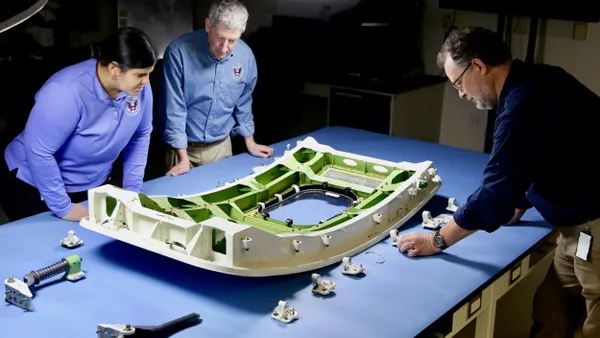Product compliance requirements are continuously evolving and increasing in complexity. More than ever, compliance programs need to be robust and agile to protect against risks like fines, blocked shipments, supply chain disruption, unhappy customers, and even loss of investor support. However, not all compliance programs are created equal. Here, we explore what differentiates a "good" program from a "best" one, and the budgetary considerations needed to advance your program’s maturity.
The "good" compliance program
A "good" compliance program has processes and documentation in place to comply with existing regulations within its industry. It asks the question, “What is the minimum we need to do to meet the spirit of the law?” However, behind the scenes, employees are operating reactively, responding to regulatory changes or customer requests as they occur, often on top of other responsibilities within the company. It’s likely they’re operating with a baseline budget that enables them to fulfill only existing regulatory commitments, without considering future changes in requirements.
While this approach may have been enough in the past, these reactive types of programs may struggle with the rapidly evolving requirements of our modern regulatory landscape. This is especially true of larger companies with proportionally large supply chains.
The "better" compliance program
Taking a step up, a "better" compliance program has a basic infrastructure that can be leveraged across numerous regulations. This allows for a faster response time when new requirements are released, as standard, adaptive processes can be quickly used to determine compliance. For example, a better program may include policies and procedures, such as a supplier code of conduct, that require suppliers to provide data upon request. In this sense, suppliers are considered partners in compliance, fostering a collaborative relationship rather than a one-sided information pull.
This type of program also has dedicated resources, both budgetary and personnel, for product compliance activities. It has robust systems in place for supplier engagement and data collection and management, and an automated tool to evaluate product designs. A “better” program appreciates the importance of internal coordination across functions like Compliance, Procurement, Quality, and Engineering, and understands the need to integrate product compliance into the company's culture.
You may even have some foresight in terms of planning and budgeting. However, this type of program doesn’t consider upcoming changes to regulations or where trends may be headed in a few years; generally, the work to address “new” regulations begins only once the rules are published.
This approach may be enough to avoid compliance failures and last-minute product changes, but your program is still reactive when it comes to meeting compliance requirements and data requests. Delays in getting products to market (or maintaining market access) are still a risk.
The "best" compliance program
At the pinnacle, a "best"; compliance program is not just proactive, but predictive. It foresees industry trends and regulatory changes, and has comprehensive resources assigned to compliance activities, including a well-defined budget and team structure that includes both dedicated internal personnel and outsourced support. It is supported by participation in industry groups, including advocacy with regulatory agencies, enabling you to give input on emerging requirements and ensure impacts to your business are considered.
A "best" program has robust and efficient systems in place for monitoring, evaluating, and sharing information about new and changing regulations and standards across the company. It incorporates compliance activities into product development and engineering processes. It has a well-defined, structured way of interacting with suppliers, managing data, and handling customer data requests. It’s resilient and adaptable, able to handle sudden influxes of regulatory changes without major disruptions.
Above all else, this approach understands that product compliance for global market access and supply chain continuity is an ongoing journey, not a destination. It includes a long-term strategy for continuous improvement and growth, and works proactively to handle future challenges, aligning itself with emerging global concerns.
Budgeting for program advancement
To advance your program from one stage to the next, careful budgeting is required, including budgeting for the following:
-
In-house coordination: Allocate budget for internal personnel who can assess risk, integrate product compliance into the company's culture, and coordinate various activities related to compliance. However, be sure to only hire the personnel you need, as an inflated headcount is often a symptom of manual or inefficient processes. For example, manually reaching out to suppliers via personal email or telephone becomes a black hole for employee time as regulations get more complex.
-
Outsourcing tactical activities: While it's important to have in-house personnel for strategic activities, outsourcing tactical activities can save on costs and ensure maximum efficiency. Some examples include data collection and management and responding to the growing number of customer requests for data.
-
Monitoring new regulations: Allocate funds for monitoring new or evolving regulations to stay ahead of changes and ensure timely compliance. This can be accomplished through consultants who know your products, markets, and customer uses of your products; subscriptions to regulatory databases; or a software platform that includes proactive regulatory updates.
-
Supplier education: Educating your suppliers on regulations, data requirements, and your company’s expectations and sustainability goals is crucial. However, dedicating staff time to this routine task can detract from other strategic business operations. Additionally, a global supply chain will likely require supplier training and outreach support in multiple languages. Consider using a proactive solution provider that offers multilingual supplier training services, ensuring your suppliers stay informed while your team remains focused on core tasks.
-
Internal and third-party systems: The need to store, manage, and access data is growing more urgent, as new and emerging regulations have increasing requirements for reporting data and providing transparency to customers. Companies need to plan for how and where to manage this data, and budget for internal technological systems or third-party solutions.
While internal systems offer customization, they require significant time and resources for development and ongoing maintenance to address new suppliers, parts, products, and regulations. On the other hand, third-party solutions, developed at scale, provide a cost-effective, efficient alternative, especially those that optimize data collection across various regulations and are routinely updated to reflect new requirements.
Increasing regulatory demand for a "best" compliance program
In the rapidly evolving regulatory landscape, a "good" compliance program that is still mostly reactive increasingly leads to more business risk. The pace of change is accelerating, and the timeframes to meet new requirements are shrinking. New regulations like the Uyghur Forced Labor Prevention Act (UFLPA) or Section 6(h) of the Toxic Substances Control Act (TSCA) are examples where changes were released with less than a 12-month implementation timeframe.
This means manufacturers can no longer count on being able to plan for focused projects to meet new requirements in the next year’s budget; they need a program that anticipates these changes and responds quickly to new requirements. This calls for a more robust, proactive approach that ensures you not only meet obligations before crucial deadlines, but also sustain growth in the face of change. The transition from a "good" to a "better" compliance program is not just beneficial — it's imperative.
Your journey to a more mature program has to start now, and it requires careful budgeting, seamless integration with other business operations, and an unyielding commitment to continual improvement. With these steps in place, your compliance program will not only insulate you from risk, but position you as a leader in supply chain sustainability.
For help creating a program that advances in maturity, download our eBook, Budgeting for Compliance. This comprehensive guide offers expert insights into major regulatory pressures expected in 2024 and provides valuable tips on allocating resources for maximum impact.
About the author: Cally Edgren, Senior Director of Sustainability at Assent
 Cally Edgren is a proven compliance program leader with experience developing, communicating, and executing company goals and strategies. She is a subject matter expert on product materials compliance as well as market access certifications and has a background in program and process development to support regulatory compliance requirements. Cally has 30 years of experience in developing and managing global compliance programs at Rockwell Automation and Kohler Co.
Cally Edgren is a proven compliance program leader with experience developing, communicating, and executing company goals and strategies. She is a subject matter expert on product materials compliance as well as market access certifications and has a background in program and process development to support regulatory compliance requirements. Cally has 30 years of experience in developing and managing global compliance programs at Rockwell Automation and Kohler Co.










